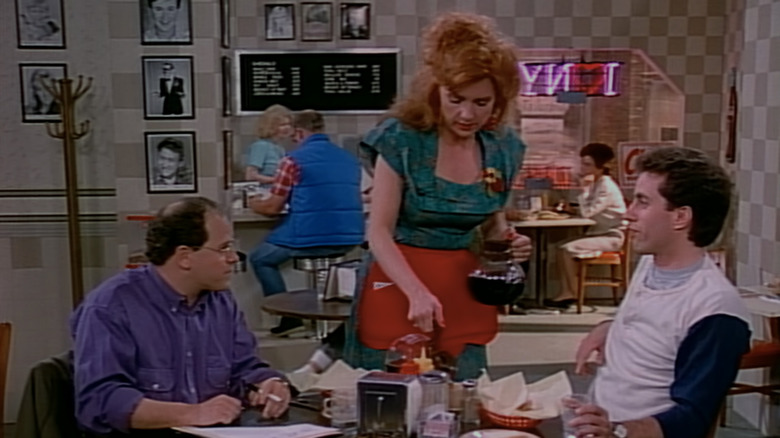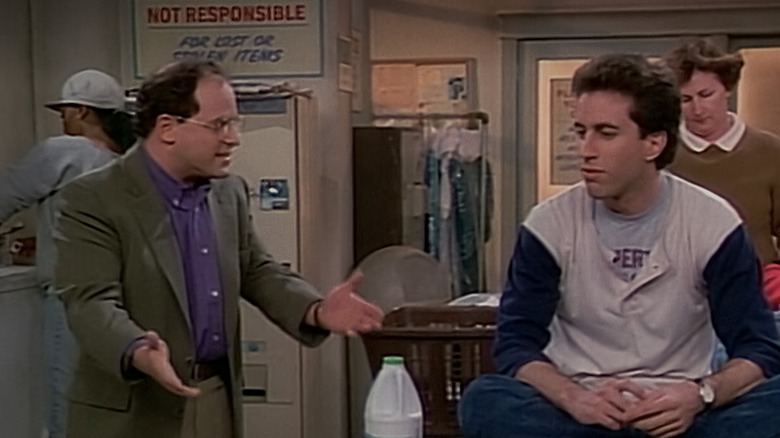The Seinfeld Pilot Was Hated By Test Audiences
The wildest part about "Seinfeld" is that it probably shouldn't have aired in the first place. The sitcom, which would run for nine seasons and conclude with a finale watched by nearly 80 million people, started off with a pilot episode that was near-entirely panned by test audiences. The network sent the first episode (originally named "The Seinfeld Chronicles") to 400 test viewers, and TV Guide would later report the feedback they received.
The complaints included comments like "No segment of the audience was eager to watch the show again," "None of the [supporting characters] were particularly liked, and viewers felt that Jerry needed a better backup ensemble," and "Viewers were unclear whether Jerry worked as a comedian or if his routines took place outside of the show as commentaries. The movement back and fourth was also considered abrupt and somewhat disorienting, particularly to older viewers."
Several NBC pilots received weak responses, but the "Seinfeld" pilot was reportedly unique in how panned it was. "It was a dagger to the heart," said Warren Littlefield, who would become president of NBC soon after. "We were afraid to go forward with something that was so strongly rejected by research."
The response isn't too surprising, considering that even "Seinfeld" fans will agree that the first episode wasn't great. There's no Elaine, which is a crime in and of itself, but even George and Kramer hadn't quite developed into the characters we remember them as. (For George in particular, it's clear that Jason Alexander hadn't yet realized his character was basically a Larry David stand-in.) The pacing throughout the pilot was also uniquely slow by the show's standards, and the episode dedicated way too much time to Jerry's stand-up routines. It's common for TV pilots to feel weaker than what would come later as showrunners work out the kinks, but rarely is the difference this glaring.
Seinfeld's growth in the ratings was slow but steady
As much as I don't like the pilot, it performed surprisingly well when NBC premiered it anyway on July 5, 1989, with decent viewership numbers and mostly positive reviews. The Associated Press wrote at the time, "[Larry] David, who was a writer-performer on ABC's 'Fridays' and a writer on 'Saturday Night Live,' does a stand-up act that seems to be so personal, it can be almost painful to watch. Pair him with the more mainstream Seinfeld, and the result is an honest, warm and amusing examination of life in the late '80s."
The show still didn't get picked up for a full season, however. It was renewed for only four episodes, which didn't air until nearly a year afterward, in May 1990. The ratings were similarly modest and the reviews were just encouraging enough to get them picked up for a twelve-episode second season. One thing that helped was the addition of Elaine in the second episode. TV critic Robert Strauss wrote at the time, "Former girlfriends usually make quick guest appearances in shows like 'Cheers' and 'Cosby,' but I really like the idea of an old flame who sticks around like the residue of melted wax at the south end of the candle."
Elaine, and the show's total lack of interest in any sort of will they/won't-they dynamic between her and Jerry, is part of what helped set "Seinfeld" apart from so many of its peers. Not everyone jived with the show's unsentimental approach at first, but they could still acknowledge it as something new and different. It helped that "Seinfeld" existed in a TV landscape that was a bit more forgiving of shows that weren't massive hits straight out of the gate; while modern Netflix would unceremoniously cancel it within a month or two, the heads at NBC saw the potential in "Seinfeld" and decided to let it keep going for nearly four seasons before the show fully took off.
Although the show seemed to have taken the advice from those early pilot viewers and evolved the series to something more palatable, Jerry Seinfeld and Larry David never actually saw the test screening feedback until the show had already become a hit, when the criticisms had lost any of the sting they once might've had. "Larry and I both hung it up near our toilets," Seinfeld said at the time. "We thought if someone goes in to use this bathroom, this is something they should see. It fits that moment."

